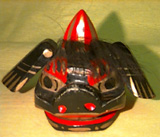

Toys for adults? You'd better believe it. Welcome to the playful
side of Mingei. A far reach from mere child's play, the "playful arts"
are loaded with great depth and history, as well as mythological and religious
connotations which persist into the present day. Each figurine tells a unique
story. Whether serving to ward off evil spirits, bring good fortune, or protect
a rightful owner, Japanese folk toys are a respected and integral part of Japanese
folklore. The following examples are a small selection from a 500+ piece collection
maintained by the Academy's Department of Anthropology.
PAMPAS GRASS HORNED OWL: SUSUKI-MIMIZUKU
CAS 1993-0001-0353
Dating back 250 years, the familiar grass horned owl is said to help ward off
sickness. Though the owl is generally regarded in Japan as malicious or at best
useless, this particular toy is widely recognized for its benevolence.
PAPER MAICHE DOG: INU HARIKO
CAS 1993-0001-0025
Throughout the world, dogs are regarded as guardians and protectors and Japan's
view of this animal proves to be no exception. Credited with recognizing demons
in human disguise, the dog often accompanies children traveling alone after nightfall.
Therefore, dog figurines are natural protectors for sleeping children.
RED COW: AKABEKO
CAS 1993-0007-0001
The red cow, with its trademark bobbing head, has been an important figure in
Japanese folklore for over 100 years. Like the owl, the cow is considered to be
an invaluable weapon against sickness. Most widely noted for its power to prevent
smallpox, the cow's most effective, and hence most constant attribute, is its
bright red coloring.
PAPER MAICHE TIGER: HARIKO-NO-TORA
CAS 1995-0007-0002
Serving as a symbol of power and bravery, the tiger instills a sense of awe and
reverence among the people of Japan. The tiger also occupies a niche within the
Oriental zodiac, representing specific hours or days in which certain activities
are to be steadfastly avoided.
PIGEON WHISTLE: HATO-BUE
CAS 1993-0001-0396
Clay whistles originated on Aomori, the main northern island of Japan. Though
a great variety of whistles were produced, the pigeon whistle is the most well
known. Diseases and afflictions were believed by many to be the result of evil
spirits. One such spirit, thought to cause hysteria in children, was said to be
frightened by loud sounds. As a consequence, children were encouraged to play
noisily and the pigeon whistle served as a perfect toy.
DEER AND MONKEY: SHIKASARU
CAS 1993-0001-0046
This figurine is widely associated with the Japanese island of Miyajima. At one
time the island was considered to be "divine" and was worshipped as such. Miyajima
was known for its populations of deer and monkeys and their mutually amicable
relationship with one another. While the deer was considered to be a messenger
to the gods, the monkey was regarded as both a guardian and symbol of fertility.
WHALE CART: KUJIRA-GURUMA
CAS 1993-0001-0224
The whale cart is a remnant of the whaling days of recent past. Until the early
20th century, the industry was one of the most influential and prosperous in Japan.
Originally crafted by 17th century whalers for their children, the whale cart
of today is often seen in a simpler and much less mobile form than its predecessors.
BEAR: AINU NINGYO
CAS 1993-0001-0323
The carved wooden bear finds its origins in Hokkaido, homeland of the Ainu people
of the Japanese islands. Traditional Ainu culture relies on bear hunting and salmon fishing and includes a ritual "sending back" bear ceremony known as "iomande."
KAGA LION HEAD: YUMIJISHI
CAS 1993-0001-0366
The lion or "Shishi" head seen here is a miniature representation
of that seen at the popular Japanese Lion-Dance. The main purpose of this dance
is to ward off disease, epidemics, and disaster. The lion head is seen throughout
Japan in a wide array of styles and sizes.
Toys, which upon first inspection appear to be children's playthings, can
symbolize much more. An enduring tradition worthy of appreciation, Mingei
have withstood the test of time.
The Academy would like to extend a special thanks to the donor of this collection,
the late Hiroyuki Kadota. Mr. Kadota dedicated 25 years to assembling his collection
of folk toys in order to preserve this special Japanese tradition. The Academy
would also like to acknowledge the financial support of American Airlines in
staging the Mingei exhibit. Thank you!
Visit our online
collection database to search on all of the Japanese folk toys in the
Anthropology collection. Search on Category: "Folk Toys" and Country:
"Japan."

©Mingei:
Japanese Folk Toys content and design by Nicole Schwartz, 1998.











